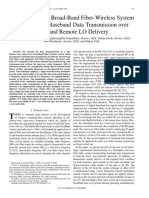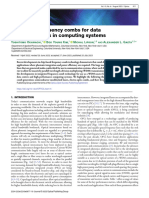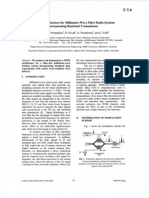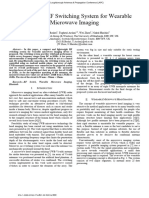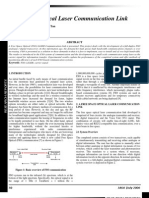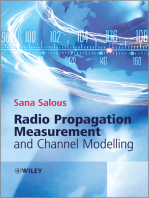Session 2P1b Radio-Over-Fiber Communication System
Session 2P1b Radio-Over-Fiber Communication System
Uploaded by
Bernard NarhCopyright:
Available Formats
Session 2P1b Radio-Over-Fiber Communication System
Session 2P1b Radio-Over-Fiber Communication System
Uploaded by
Bernard NarhOriginal Title
Copyright
Available Formats
Share this document
Did you find this document useful?
Is this content inappropriate?
Copyright:
Available Formats
Session 2P1b Radio-Over-Fiber Communication System
Session 2P1b Radio-Over-Fiber Communication System
Uploaded by
Bernard NarhCopyright:
Available Formats
Session 2P1b Radio-Over-Fiber Communication System
Implementation of a Radio over Fiber System in a Geographically-distributed Optical Network Sodr e Arismar Cerqueira, Jr., D. C. Valente e Silva, M. A. Q. R. Fortes, L. F. da Silva, O. C. Branquinho, M. L. F. Abbade, . . . . . . . . . . . . . . . . . . . . . . . . . . . . . . . . . . . . . . . . . . . . . . . . . . . . . . . . . . . . . . . . . . . . . . . . . . . 60 GHz Radio over Fiber Transmission System Based on Integrative Cascade MZM Cheng Hong, Siyu Liu, Cheng Zhang, Zhangyuan Chen, Weiwei Hu, . . . . . . . . . . . . . . . . . . . . . . . . . . . . . . Single-mode Modulation Using Injection-locked Fabry-Perot Laser in Radio-over-Fiber System Cheng Zhang, Mingjin Li, Siyu Liu, Cheng Hong, Weiwei Hu, Zhangyuan Chen, . . . . . . . . . . . . . . . . . A Scheme of Photonic Notch Filter Using DGD Method for Radio-over-Fiber Communication Systems Hanhong Gao, Jinxuan Wu, Zhao Tu, Cheng Zhang, Dandan Wu, Weiwei Hu, Zhangyuan Chen, A Scheme of Microwave Photonic Filter Based on Hi-Bi Fiber Dandan Wu, Weiwei Hu, Zhangyuan Chen, . . . . . . . . . . . . . . . . . . . . . . . . . . . . . . . . . . . . . . . . . . . . . . . . . . . . . . . . The Trend of Designing Rotation Sensors Based on Highly Dispersive Resonating Structures Zinan Wang, Xiaomu Wu, Chao Peng, Rui Hui, Xuefeng Luo, Zhengbin Li, Anshi Xu, . . . . . . . . . .
266 267 268 269 270 271
265
266
Progress In Electromagnetics Research Symposium Abstracts, Beijing, China, March 2327, 2009
Implementation of a Radio over Fiber System in a Geographically-distributed Optical Network
S. Arismar Cerqueira, Jr.1 , D. C. Valente e Silva2 , M. A. Q. R. Fortes1 , L. F. da Silva2 , O. C. Branquinho2 , and M. L. F. Abbade2
2
Optics and Photonics Research Center, UNICAMP, Brazil Faculdade de Engenharia El etrica, Pontif cia Universidade Cat olica de Campinas, Brazil
Abstract The next generation of access networks is rushing the needs for the convergence
of wired and wireless services to oer end users greater choice, convenience and variety in an ecient way [1]. This scenario will require the simultaneous delivery of voice, data and video services with mobility feature to serve the xed and mobile users in a unied networking platform. In other words, new telecom systems require high-transmission bandwidths and reliable mobility. The Radio over Fiber (RoF) technology represent a key solution for satisfying these requirements, since it jointly takes advantage of the huge bandwidth oered by optical communications systems with the mobility and exibility provided by wireless systems. RoF systems consist of heterogeneous networks formed by wireless and optical links. Unlike traditional optical communications networks, in which a baseband signal in transmitted into the optical bers, in RoF systems one or multiple analogous carriers are transported into the bers. The transmission is performed by directly or externally modulating lasers by the analogous radio frequency signal. On the receiver side, the transmitted signal is recovered by using a photodiode. Compared to traditional optical systems, RoF technology provides the advantage of eliminating the gateways, since there is no need for analogous-digital or digital-analogous conversions. This simplies the system complexity and reduces the operational costs. RoF technology has been investigated by many Research Groups in the last years. However, the great majority of works published in literature are based on simulations and/or experiments carried out in laboratories. This work presents an implementation of a Radio over Fiber system based on IEEE 802.15.4 standard, in a geographically-distributed optical network called KyaTera [2]. Lasers were directly modulated by a RF signal at 2.4 GHz with Quadrature Phase Shift Keying (QPSK) modulation. This signal was launched into hundreds of kilometers from KyaTera Network under real conditions of temperature, pressure, humidity and wind. The optical signal was received by a fast photodiode, converted to electrical signal and then retransmitted by an antenna with gain G = 12 dBi. Finally the wireless signal was obtained by a receiver antenna. Simulations based on Split Step Fourier Method were carried out for predicting the system performance. The performance parameters evaluated in the experiments were the electrical Signal to Noise Radio (SNR) and Frame Error Rate (FER) of the transmitted RF signal. Experimental results show no performance degradation of the transmitted radio frequency signal.
REFERENCES
1. Jia, Z., J. Yu, G. Ellinas, and G.-K. Chang, Key enabling technologies for optical wireless networks optical millimeter wave generation wavelength reuse and architecture, Journal of Lightwave Technology, Vol. 25, 34523471, 2007. 2. www.kyatera.fapesp.br.
Progress In Electromagnetics Research Symposium Abstracts, Beijing, China, March 2327, 2009
267
60 GHz Radio over Fiber Transmission System Based on Integrative Cascade MZM
Cheng Hong, Siyu Liu, Cheng Zhang, Zhangyuan Chen, and Weiwei Hu State Key Laboratory on Advanced Optical Communication Systems & Networks Peking University, Beijing, China
Abstract We experimentally demonstrated a Radio over ber transmission system which
works in 60 GHz band with 2.5 Gbps bit Rate over 22 km SMF, using an integrative cascade MZM modulator. Introduction: Radio over ber technology is considered to be a potential solution to the broadband access networks. Making use of convergence of mobility of wireless and good transmission channel property of optical ber, Radio over ber technology can easy transmit several Gigabit per second. Here we experimentally demonstrated the transmission system for 2.5 Gps on 60 GHz microwave over 22 km SMF. Cascade MZM modulation method is a simple way to generate two coherence optical modes to beat in photodetector for producing microwave signal. Experimental Setup and Result:
1E-5 1E-6
DFB
MZM MZM
EDFA
1E-7 1E-8 1E-9 1E-10
22km SMF
30 GHz
BER
2. 5Gbps
Mix
PD 60GHz
BER
1E-11 1E-12
-3.5
-3.0
-2.5
-2.0
-1.5
-1.0
-0.5
received opti -Pw (dBm)
Figure 1: Experiment setup.
Figure 2: Received BER.
The experimental setup is show as Fig. 1. An integrative cascade MZM as modulator. One MZM is used as microwave carrier modulator bias at null point; the other is used as data modulator and set at linear bias point. The transmission bit error rate is verse received optical power is show as Fig. 2. Conclusions: A primary demonstration of downlink Radio over system is realized by an integrative cascade MZM as modulator and coherent demodulation receiver. ACKNOWLEDGMENT This work is supported by The National High Technology Research and Development Program of China (863Program) under Grant 2006AA01Z261 and The National Natural Science Foundation of China (NSFC) under Grant 60736003.
REFERENCES
1. Koonen, T., Fiber to the home/ber to the premises: What, where, and when?, Proc. IEEE, Vol. 94, No. 5, 911934, May 2006.
268
Progress In Electromagnetics Research Symposium Abstracts, Beijing, China, March 2327, 2009
Single-mode Modulation Using Injection-locked Fabry-Perot Laser in Radio-over-Fiber System
Cheng Zhang, Mingjin Li, Siyu Liu, Cheng Hong, Weiwei Hu, and Zhangyuan Chen State Key Laboratory on Advanced Optical Communication Systems & Networks Peking University, Beijing, China
Abstract Radio-over-Fiber (RoF) system has been considered a promising technology for future broadband wireless communication. Recently, many schemes have been proposed to realize a low-cost and high-performance RoF system. The commonly used method to generate millimeter wave (MMW) in these systems is optical heterodyning technique which use two correlated optical modes to beat a high-quality MMW. And usually the data is uploaded to the MMW by just modulating these two modes. However, standard modulation of two correlated modes will suer from chromatic dispersion which results in a radio frequency (RF) fading and limits the transmission distance. Single-mode modulation is proposed to overcome this problem. But the former method using a Mach-Zehnder (MZ) interferometer lter is too complex to be practical. In this paper, we propose a new approach to realize single-mode modulation using injection-locked Fabry-Perot laser dioxide (FPLD). In the experiment setup, the DFB lasers output is coupled into an intensity modulator which is driven by the reference frequency at 15 GHz from a signal generator. The modulator output is sent to an optical notch lter to select the rst-order sidebands whose mode-spacing is 30 GHz. An EFDA and an attenuator are used to get the proper injection power and its output is connected with a 60 GHz mode-spacing FPLD through a three-port optical circulator (OC) for single-mode injection-locking. A polarization controller (PC) is used to control the input state of polarization to the FP laser diode. The intermediate frequency (IF) signal is uploaded by modulating the current of FPLD. Finally, the single locked mode and the other reected mode are transmitted for 44.4 km and sent to a 70 GHz photo detector (PD) for 30 GHz MMW generation. The electrical signal sidebands on both sides of 30 GHz carrier are measured for dierent IF. Another experiment using standard dual-mode modulation has also been done to for comparing data. Figure 1 compares the side power after 44.4 km SMF transmission for both single-mode modulation and dual-mode modulation. Dierent RF powers for single-mode modulation are also test in our experiment. Compared to dual-mode modulation, it can be found that the proposed single-mode modulation is immune to RF signal fading due to the chromatic dispersion.
Frequency (GHz)
Figure 1: Received electrical power for dierent modulation frequency after 44.4 km SMF transmission. ACKNOWLEDGMENT
This work is supported by The National Natural Science Foundation of China (NSFC) under Grant 60736003.
Progress In Electromagnetics Research Symposium Abstracts, Beijing, China, March 2327, 2009
269
A Scheme of Photonic Notch Filter Using DGD Method for Radio-over-Fiber Communication Systems
Hanhong Gao, Jinxuan Wu, Zhao Tu, Cheng Zhang, Dandan Wu, Weiwei Hu, and Zhangyuan Chen State Key Laboratory of Advanced Optical Communication Systems & Networks Peking University, Beijing, China
Abstract Microwave photonics has been a popular research eld. The photonic lters can
provide a large tunability and a high Q factor besides advantages such as low loss, light weight, immunity to electromagnetic interference and capability to overcome electronic bottleneck. Therefore, a number of photonic microwave lters have been reported in the literature. Several methods have been demonstrated using ber delay lines, most of which use several xed lengths of ber to achieve stepped time delay. It is recently demonstrated that non-uniformly spaced taps can implement a photonic microwave lter with an arbitrary band-pass response, which would have the same spectral characteristics as a photonic microwave delay-line lter with true negative or complex coecients. Another particular application of interest is the transversal microwave lter, which can be classied as two kinds: optically coherent and optically incoherent. Besides, a tunable ring resonator in polymeric wave-guides was exploited to implement an integrated photonic microwave band-pass lter operating at around 10 GHz. We propose a recongurable and continuously tunable photonic notch lter implementing a technique using a dierential group delay (DGD) element including a tunable laser source, a polarization beam splitter (PBS), an adjustable optical delay line, three polarization-preserving bers (PPF) and one polarization-preserving ber coupler. First, electro-optical modulator (EOM) modulates the laser output with RF signal. After passing PBS, the beam separates into two with orthogonal polarizations, which will travel separately along two PPF. In addition, one beam will experience delay through adjustable optical delay line. Therefore they will experience dierent time delay. They are combined using the polarization-preserving coupler and the electric signal is detected by photo detector (PD). Finally, a vector network analyzer is used to measure the characters of this microwave photonic lter. The time delay is set to about 100 ps, and a lter with free spectral range (FSR) approximately 10 GHz is realized. The notch rejection ratio is larger than 20 dB. By varying the time delay, dierent FSR will be accomplished. Whats more, the central frequency of laser source is adjusted deviating from the previous frequency from 0 to 10 GHz. In the meantime the lter varies from low-pass lter to band-pass lter and back to low-pass lter. This lter conguration has several advantages comparing with previous schemes. Firstly, adjustable optical delay line can be used to adjust FSR of the lter, making it continuously tunable. This delay line can achieve a wide range of FSR. Secondly, it is recongurable through the adjustment of the central frequency of the laser source. The lter frequency response can be changing from band-pass lter to low-pass lter. Lastly, this conguration can be used in varieties of radio-over-ber communication systems to achieve a better lter performance. ACKNOWLEDGMENT
This work is supported by the National Undergraduate Innovative Test Program and the National Natural Science Foundation of China (NSFC) under Grant No. 60736003.
270
Progress In Electromagnetics Research Symposium Abstracts, Beijing, China, March 2327, 2009
A Scheme of Microwave Photonic Filter Based on Hi-Bi Fiber
Dandan Wu, Weiwei Hu, and Zhangyuan Chen State Key Laboratory of Advanced Optical Communication Systems & Networks Peking University, Beijing, China
Abstract Over the past several decades Microwave photonic lter (MPFs) has attracted a
lot of interest due to the processing of radio-frequency (RF) signals in the optical domain, saving bulky OE and EO conversion parts, and with the advantages of wide bandwidth, immunity to electromagnetic interference, low loss, tunability and recongurability, therefore they are widely applied to phased-array beamforming, radar, mobile communications, and radio-over-ber (ROF) systems. The MPFs can be operated in incoherent or coherent regime. Incoherent lters are more stable against environmental conditions. Therefore, until now many kinds of incoherent MPFs have been reported in literatures. The conventional incoherent MPFs have been proposed using dierent optical delay lines or electrically summing congurations, then the intensity of the modulated light outputs from dierent taps are added. However, the former limited the free spectrum range (FSR) of the MPFs, and the later lost the advantages of optical domain signal processing. Recently, polarization synthesizing method has been reported to realize incoherent operation, which is based on dierential group delay (DGD) element with two ber delay lines. In this paper, we propose a novel structure of microwave photonic lter shown in Fig. 1. The radio frequency (RF) signal of a network analyzer drives an electrooptic modulator that modulates the output of a tunable laser source. The modulated optical signal transmits along a coupler and a three-port polarization beam splitter (PBS). One of the optical beams transmits clockwise along fast-axis of the Hi-Bi ber, and the other transmits anti-clockwise along slow-axis of the Hi-Bi ber. Because the Hi-Bi ber has a large refractive index dierence between its fast and slow axis, the time delay dierence will be induced. The two orthogonal optical signals, which are dierently delayed, are combined without interference and directed to the output of the coupler.
laser
EOM
PBS
Hi-Bi Fiber
Network Analyzer
PD
Figure 1: The experiment conguration of Microwave Photonic Notch Filter. Theoretical calculation show that the MPF structure can provide approximately 10 GHz FSR corresponding to the 100 ps time delay. The notch rejection ratio is larger than 20 dB. This MPF has several advantages comparing with previous schemes. First, its more stable and simpler due to using only one ber delay line, which can implement a wide range of FSR. Second, through the employment of temperature controller or PZT to adjust the length of the Hi-Bi ber, the MPF will be tunable and recongurable. The detailed experimental results will be discussed in the manuascript. ACKNOWLEDGMENT
This work is supported by The National Natural Science Foundation of China (NSFC) under Grant 60736003.
Progress In Electromagnetics Research Symposium Abstracts, Beijing, China, March 2327, 2009
271
The Trend of Designing Rotation Sensors Based on Highly Dispersive Resonating Structures
Zinan Wang, Xiaomu Wu, Chao Peng, Rui Hui, Xuefeng Luo, Zhengbin Li, and Anshi Xu State Key Laboratory on Advanced Optical Communication Systems & Networks School of Electronics Engineering and Computer Science, Peking University, 100871, China
Abstract Rotation sensors, which are also known as gyroscopes, are widely used for industrial
and military purpose. The basic idea of it is to detect the phase shift induced by the Sagnac eect in a closed loop [1]. Over the past few decades, gyroscope designing based on dierent structures have been intensively studied [111], and highly dispersive structures are mostly considered [4 11]. Its recognized that dispersion cannot inuence the magnitude of the Sagnac eect [2, 12]. But there are dierent manifestations in highly dispersive medium and resonator structure. For rotation sensors based on highly dispersive medium, as Doppler eect is proposed to be the intrinsic reason to enhance their sensitivity, they suit only situations when relative motion exists between the interferometer and the medium [10]. But its dierent for sensors based on highly dispersive resonating structures, such as coupled-resonator slow-light waveguide structures [9] and various photonic crystal geometries. These structures may possess huge Q-factor and they are extremely susceptible to the phase perturbation in the light path. The Sagnac eect will induce additional phase shift in the light path when such a structure is rotating, and then inuence its response. The total phase shift will be enlarged as a result. It shows that the highly dispersive resonating structure will improve the sensitivity in rotation sensing [10]. An example of highly dispersive resonating structures is the CRIT (coupled-resonator-induced transparency) structure, which has highly dispersive property with low absorption at its resonant frequency [13]. The gyroscope based on this CRIT structure is proved to be highly sensitive, and it has the potential to be made in a compact size [11]. The active CRIT structure, where the dispersion can be optically tailored, can further increase the performances of CRIT based gyroscopes [14]. Electrodynamics in rotating optical elements is quite useful in designing rotation sensors. This is widely used in modeling the Sagnac eect [8, 1518]. One way of using it is the application in the Finite-Dierence Time-Domain (FDTD) algorithm [18]. This FDTD method is a promising tool to accurately analyze, design and optimize rotation sensors.
REFERENCES
1. Post, E. J., Sagnac eect, Rev. Mod. Phys., Vol. 39, 475493, 1967. 2. Arditty, H. J. and H. C. Lefevre, Sagnac eect in ber gyroscopes, Opt. Lett., Vol. 6, 401403, 1981. 3. Bergh, R. A., H. C. Lefevre, and H. J. Shaw, An overview of ber-optic gyroscopes, J. Lightwave Technol., Vol. 2, 91107, 1984. 4. Lefevre, H. C., The Fiber-optic Gyroscope, Artech House Publishers, 1993. 5. Leonhardt, U. and P. Piwnitski, Ultrahigh sensitivity of slow-light gyroscope, Phys. Rev. A, Vol. 62, 055801, 2000. 6. Steinberg, B. Z., Rotating photonic crystals: A medium for compact optical gyroscopes, Phys. Rev. E, Vol. 71, 056621, 2005. 7. Matsko, B., A. A. Savchenkov, V. S. Ilchenko, and L. Maleki, Optical gyroscope with whispering gallery mode optical cavities, Opt. Commun., Vol. 233, 107112, 2004. 8. Steinberg, B. Z. and A. Boag, Splitting of microcavity degenerate modes in rotating photonic crystals the miniature optical gyroscopes, J. Opt. Soc. Am. B, Vol. 24, 142151, 2006. 9. Scheuer, J. and A. Yariv, Sagnac eect in coupled-resonator slow-light waveguide structures, Phys. Rev. Lett., Vol. 96, 053901, 2006. 10. Peng, C., Z. Li, and A. Xu, Rotation sensing based on a slow light resonating structure with high group dispersion, Appl. Opt., Vol. 19, 41254131, 2007. 11. Peng, C., Z. Li, and A. Xu, Optical gyroscope based on a coupled resonator with the alloptical analogous property of electromagnetically induced transparency, Appl. Opt., Vol. 15, 38643875, 2007.
272
Progress In Electromagnetics Research Symposium Abstracts, Beijing, China, March 2327, 2009
12. Leeb, W. R., G. Schiner, and E. Scheiterer, Optical ber gyroscopes: Sagnac or Fizeau eect, Appl. Opt., Vol. 18, 12931295, 1979. 13. Smith, D., H. Chang, K. A. Fuller, A. T. Rosenberger, and R. W. Boyd, Coupled-resonatorinduced transparency, Phys. Rev. A, Vol. 69, 063804, 2004. 14. Dumeige, Y., T. Nguy en, L. Ghi sa, S. Trebaol, and P. F eron, Measurement of the dispersion induced by a slow-light system based on coupled active-resonator-induced transparency, Phys. Rev. A, Vol. 78, 013818, 2008. 15. Shiozawa, T., Phenomenological and electron-theoretical study of the electrodynamics of rotating systems, Proc. IEEE, Vol. 61, 16941702, 1973. 16. Anderson, J. L. and J. W. Ryon, Electromagnetic radiation in accelerated systems, Phys. Rev., Vol. 181, 17651775, 1969. 17. Van Bladel, J. Relativity and Engineering, Springer, Berlin, 1984. 18. Peng, C., R. Hui, X. Luo, Z. Li, and A. Xu, Finite-dierence time-domain algorithm for modeling Sagnac eect in rotating optical elements, Appl. Opt., Vol. 8, 52775290, 2008.
You might also like
- Project ReportDocument35 pagesProject ReportNitish Gupta100% (2)
- CANON imageRUNNER ADVANCE 8085, 8095, 8105 Series Parts List PDFDocument204 pagesCANON imageRUNNER ADVANCE 8085, 8095, 8105 Series Parts List PDFokeinfo100% (1)
- Photonic Generation of Millimeter Wave in Radio-over-Fiber Transmission SystemDocument4 pagesPhotonic Generation of Millimeter Wave in Radio-over-Fiber Transmission SystemLuisNo ratings yet
- Millimeter-Wave Broad-Band Fiber-Wireless System Incorporating Baseband Data Transmission Over Fiber and Remote LO DeliveryDocument9 pagesMillimeter-Wave Broad-Band Fiber-Wireless System Incorporating Baseband Data Transmission Over Fiber and Remote LO DeliverySourav DebNo ratings yet
- A Review On Signal GenerationDocument10 pagesA Review On Signal GenerationFarhan FarhanNo ratings yet
- O and Q SKRDocument14 pagesO and Q SKRAkash SrivastavaNo ratings yet
- Multiband 60-Ghz Wireless Over Fiber Access System With High Dispersion Tolerance Using Frequency Tripling TechniqueDocument7 pagesMultiband 60-Ghz Wireless Over Fiber Access System With High Dispersion Tolerance Using Frequency Tripling TechniqueSourav DebNo ratings yet
- Optisystem ReportDocument14 pagesOptisystem ReportAryan KumarNo ratings yet
- Demonstration of 256 QAM 10 Gbps Signal TransmissiDocument14 pagesDemonstration of 256 QAM 10 Gbps Signal TransmissipodcastautismoemfocoNo ratings yet
- Photonic RadarDocument5 pagesPhotonic RadarHariNathNo ratings yet
- 56-Gbit/s PAM-4 Optical Signal Transmission Over 100-km SMF Enabled by TCNN Regression ModelDocument15 pages56-Gbit/s PAM-4 Optical Signal Transmission Over 100-km SMF Enabled by TCNN Regression Modelasf1No ratings yet
- Vol 3 No 6 Page 940 To 942Document3 pagesVol 3 No 6 Page 940 To 942HungNguyenVietNo ratings yet
- Chip-Scale Frequency Combs For Data Communications in Computing SystemDocument19 pagesChip-Scale Frequency Combs For Data Communications in Computing SystemHaojia SUNNo ratings yet
- Impact of Optical Transmission On Multiband OFDM Ultra-Wideband Wireless System With Fiber DistributionDocument12 pagesImpact of Optical Transmission On Multiband OFDM Ultra-Wideband Wireless System With Fiber DistributionSourav DebNo ratings yet
- Control and Signal Processing For Time Stretched Photonic ADCDocument3 pagesControl and Signal Processing For Time Stretched Photonic ADCHariNathNo ratings yet
- Novel QPSK Modulation For DWDM Free Space Optical Communication SystemDocument6 pagesNovel QPSK Modulation For DWDM Free Space Optical Communication SystemLương Xuân DẫnNo ratings yet
- 32-QAM Radio Transmission Over Multimode Fibre Beyond The Fibre BandwidthDocument4 pages32-QAM Radio Transmission Over Multimode Fibre Beyond The Fibre BandwidthFarhanny SitumorangNo ratings yet
- project_reportDocument8 pagesproject_reportAli AkkasNo ratings yet
- WDM-PON Architecture For Radio Over FiberDocument4 pagesWDM-PON Architecture For Radio Over FiberJohnJairoArangoQuinteroNo ratings yet
- Signal-Carrier Interleaved Optical OFDM For Direct Detection Optical CommunicationDocument7 pagesSignal-Carrier Interleaved Optical OFDM For Direct Detection Optical CommunicationAliAzarniaNo ratings yet
- Ao 59 19 5723Document6 pagesAo 59 19 5723Kimi StrryNo ratings yet
- Overcome Chromatic DispersionDocument6 pagesOvercome Chromatic DispersionDr-Mandeep SinghNo ratings yet
- Optics and Laser Technology: Wenjing Xu, Xinlu Gao, Mingyang Zhao, Mutong Xie, Shanguo HuangDocument5 pagesOptics and Laser Technology: Wenjing Xu, Xinlu Gao, Mingyang Zhao, Mutong Xie, Shanguo HuangJam JacoNo ratings yet
- Modelling and Analysis of A Radio Over A Fibre SystemDocument13 pagesModelling and Analysis of A Radio Over A Fibre SystemArgentine KazunguNo ratings yet
- Ijettcs 2014 06 14 086Document5 pagesIjettcs 2014 06 14 086International Journal of Application or Innovation in Engineering & ManagementNo ratings yet
- Grover 2020Document13 pagesGrover 2020FilzaNo ratings yet
- PER and EVM Measurements of A Radio-Over-Fiber Network For Cellular and WLAN System ApplicationsDocument7 pagesPER and EVM Measurements of A Radio-Over-Fiber Network For Cellular and WLAN System ApplicationsSourav DebNo ratings yet
- Performance Analysis of WDM/SCM System Using EDFADocument5 pagesPerformance Analysis of WDM/SCM System Using EDFAeditor_ijarcsseNo ratings yet
- Fon Mod 1Document37 pagesFon Mod 1salusivasankaranNo ratings yet
- Optical and Quantum Communications: RLE GroupDocument18 pagesOptical and Quantum Communications: RLE GroupdemononesNo ratings yet
- Modulación de Radio-Sobre-La FibraDocument2 pagesModulación de Radio-Sobre-La FibraJohnJairoArangoQuinteroNo ratings yet
- FSO Link in Haze and Fog WeatherDocument8 pagesFSO Link in Haze and Fog WeatherHANZ V2No ratings yet
- Ehsan HamidiDocument10 pagesEhsan HamidiYousef RahalNo ratings yet
- Coherent Detection Optical Ofdm SystemDocument6 pagesCoherent Detection Optical Ofdm SystemijsretNo ratings yet
- A Tutorial On Microwave PhotonicsDocument20 pagesA Tutorial On Microwave PhotonicsDr-Mandeep SinghNo ratings yet
- Modelling PM-BPSK Signals For Coherent Optical Transmission Over Single-Mode FiberDocument5 pagesModelling PM-BPSK Signals For Coherent Optical Transmission Over Single-Mode FiberGeetikaNo ratings yet
- Q-I tr0&: A Architecture For Millimeter-Wave Fiber-Radio Systems Incorporating Baseband TransmissionDocument4 pagesQ-I tr0&: A Architecture For Millimeter-Wave Fiber-Radio Systems Incorporating Baseband TransmissionRajiniGopiNo ratings yet
- Microwave Photonic Array RadarsDocument15 pagesMicrowave Photonic Array RadarsJessica greenNo ratings yet
- The Evolution of Optical Fibre Communication SystemsDocument13 pagesThe Evolution of Optical Fibre Communication SystemsKuldeep SharmaNo ratings yet
- Optical Amplifier Compatible Long Distance Secure Key Distribution System Based On Random Phase Fluctuations For WDM SystemsDocument5 pagesOptical Amplifier Compatible Long Distance Secure Key Distribution System Based On Random Phase Fluctuations For WDM SystemsgtemporaoNo ratings yet
- A Radio-On-Hybrid WDM Transport System Based On Mutually Injection-Locked FP LdsDocument4 pagesA Radio-On-Hybrid WDM Transport System Based On Mutually Injection-Locked FP LdslalitdeadgoalsNo ratings yet
- Photonic Scheme For The Generation of Background-Free Phase-Coded Microwave Pulses and Dual-Chirp Microwave WaveformsDocument9 pagesPhotonic Scheme For The Generation of Background-Free Phase-Coded Microwave Pulses and Dual-Chirp Microwave WaveformsJessica greenNo ratings yet
- Microwave Photonics Combines Two Worlds: José Capmany and Dalma NovakDocument12 pagesMicrowave Photonics Combines Two Worlds: José Capmany and Dalma Novakqaasim asadNo ratings yet
- Siddhasen 2Document10 pagesSiddhasen 2kimak00001No ratings yet
- Ofc Notes PDFDocument116 pagesOfc Notes PDFSudha Rani50% (2)
- A Compact RF Switching System For Wearable Microwave ImagingDocument4 pagesA Compact RF Switching System For Wearable Microwave ImagingrajusanskrutiNo ratings yet
- Mod 1-1Document52 pagesMod 1-1swathisunil1582No ratings yet
- Digital Coherent Detection of Multi-GigabitDocument2 pagesDigital Coherent Detection of Multi-GigabitAbdelgader AbdallaNo ratings yet
- 1999 - Wideband Radio Channel Measurement System at 2 GHZDocument6 pages1999 - Wideband Radio Channel Measurement System at 2 GHZbajrang bansalNo ratings yet
- Luigi Giubbolini - Time/Space-Probing Interferometer For Plasma DiagnosticsDocument14 pagesLuigi Giubbolini - Time/Space-Probing Interferometer For Plasma DiagnosticsLuigi GiubboliniNo ratings yet
- PC 2 PC Laser Communication SystemDocument3 pagesPC 2 PC Laser Communication SystemMamun LimonNo ratings yet
- A Full Duplex DWDM-RoMCF System at 60 GHZ Based On Four Quadruple Frequency Between 28 Micro Base StationsDocument9 pagesA Full Duplex DWDM-RoMCF System at 60 GHZ Based On Four Quadruple Frequency Between 28 Micro Base StationsFares AbderraoufNo ratings yet
- A Novel Scheme For Optical Millimeter Wave Generation Using Linbo Mach - Zehnder Modulator Without AmplifierDocument8 pagesA Novel Scheme For Optical Millimeter Wave Generation Using Linbo Mach - Zehnder Modulator Without AmplifierArvind ChakrapaniNo ratings yet
- Analysis of Free Space Optical Communication With Different Modulation SchemesDocument5 pagesAnalysis of Free Space Optical Communication With Different Modulation SchemesShibin LeoNo ratings yet
- FOC Unit-1Document24 pagesFOC Unit-1NAGASWATHI NIDAMANURINo ratings yet
- Signal Integrity: From High-Speed to Radiofrequency ApplicationsFrom EverandSignal Integrity: From High-Speed to Radiofrequency ApplicationsNo ratings yet
- Inverse Synthetic Aperture Radar Imaging With MATLAB AlgorithmsFrom EverandInverse Synthetic Aperture Radar Imaging With MATLAB AlgorithmsNo ratings yet
- Software Radio: Sampling Rate Selection, Design and SynchronizationFrom EverandSoftware Radio: Sampling Rate Selection, Design and SynchronizationNo ratings yet
- Telecommunications Legislation and Regulation in GhanaDocument21 pagesTelecommunications Legislation and Regulation in GhanaBernard NarhNo ratings yet
- DAS Solutions 2Document4 pagesDAS Solutions 2Bernard NarhNo ratings yet
- Ghana Telecom University College PDFDocument1 pageGhana Telecom University College PDFBernard NarhNo ratings yet
- 8086 Instruction SetDocument92 pages8086 Instruction SetBernard NarhNo ratings yet
- P5 14 Maruri SpainDocument13 pagesP5 14 Maruri SpainBernard NarhNo ratings yet
- A Radio Over Fiber Based Wireless Access Network Architecture For Rural AreasDocument5 pagesA Radio Over Fiber Based Wireless Access Network Architecture For Rural AreasBernard NarhNo ratings yet
- Noor, A. (2008) - Ethics, Religion and Good Governance, JOAAG, Vol. 3. No. 2Document16 pagesNoor, A. (2008) - Ethics, Religion and Good Governance, JOAAG, Vol. 3. No. 2Bernard NarhNo ratings yet
- 05 Aust Smartcom May 06Document20 pages05 Aust Smartcom May 06Bernard NarhNo ratings yet
- FPC ProblemSet1 2011-10-26 SolutionDocument2 pagesFPC ProblemSet1 2011-10-26 SolutionBernard Narh100% (2)
- Datasheet - Easergy P5 Protection Relays - P5F30Document3 pagesDatasheet - Easergy P5 Protection Relays - P5F30felipereislima9304No ratings yet
- Isf DF10KDocument1 pageIsf DF10KManh PhamNo ratings yet
- Gate 2022 Online Test Series EeDocument7 pagesGate 2022 Online Test Series EeShaik ShaikNo ratings yet
- In Circuit Flash ProgrammingDocument1 pageIn Circuit Flash ProgrammingSatyanarayana Reddy KarriNo ratings yet
- Indian Standard: Recommended Current Ratings For CablesDocument15 pagesIndian Standard: Recommended Current Ratings For CablesMathi PrakashNo ratings yet
- Tcss BitsDocument13 pagesTcss BitsrajeshNo ratings yet
- NSC PLL Handbook DeansBook 4 01Document185 pagesNSC PLL Handbook DeansBook 4 01Muhammad IkhsanNo ratings yet
- AQUA24T 230T ReginDocument2 pagesAQUA24T 230T ReginLeed ENNo ratings yet
- Equipment BatteryDocument3 pagesEquipment Batteryroadkill1954_3977635No ratings yet
- Ficha Tecnica Termoanemometro Extech An100 - An200Document1 pageFicha Tecnica Termoanemometro Extech An100 - An200alex arizaNo ratings yet
- An5878 How To Design A Robust Automotive Can System StmicroelectronicsDocument29 pagesAn5878 How To Design A Robust Automotive Can System StmicroelectronicsBeto YoshidaNo ratings yet
- 01.4 Agx-1 BrochureDocument16 pages01.4 Agx-1 BrochurethecrowdedhouseNo ratings yet
- Digital CommsDocument6 pagesDigital CommsZen Christopher MamagatNo ratings yet
- Ebook 3.2.2.1ElectricalAutomationDocument1 pageEbook 3.2.2.1ElectricalAutomationTj ShowNo ratings yet
- Onkyo SKW 204 Service ManualDocument11 pagesOnkyo SKW 204 Service ManualLuis Tellez CedeñoNo ratings yet
- DatasheetDocument14 pagesDatasheetJNo ratings yet
- Digsilent Powerfactory: Technical Reference DocumentationDocument12 pagesDigsilent Powerfactory: Technical Reference DocumentationmingNo ratings yet
- CR NotesDocument22 pagesCR NotesvanithapremkumarNo ratings yet
- The Case of MicromaxDocument1 pageThe Case of MicromaxPranav PatilNo ratings yet
- Supply, Installation and Commissioning of Testing EquipmentDocument110 pagesSupply, Installation and Commissioning of Testing Equipmenttmahfuz142630No ratings yet
- Introducation To Linear Control SystemsDocument27 pagesIntroducation To Linear Control SystemsAhsan ZareenNo ratings yet
- Elcompo-FbtDocument3 pagesElcompo-Fbtkachappilly2012No ratings yet
- AIX For System AdministratorsDocument8 pagesAIX For System Administratorsraj_esh_0201No ratings yet
- Cloud Managed Access Switches: MS220 & MS320 SeriesDocument11 pagesCloud Managed Access Switches: MS220 & MS320 SeriesaykargilNo ratings yet
- VoLTE KPIDocument14 pagesVoLTE KPIAqeel SherGillNo ratings yet
- Data SheetDocument39 pagesData SheetEric ArcherNo ratings yet
- Fifo RTL CodeDocument5 pagesFifo RTL CodePranav ToorNo ratings yet
- Content Beyond The Syllabus Unit 1Document5 pagesContent Beyond The Syllabus Unit 1ANBARASU LNo ratings yet
- DSD TECH HM-10 DatasheetDocument38 pagesDSD TECH HM-10 Datasheetteguh ari bowoNo ratings yet



